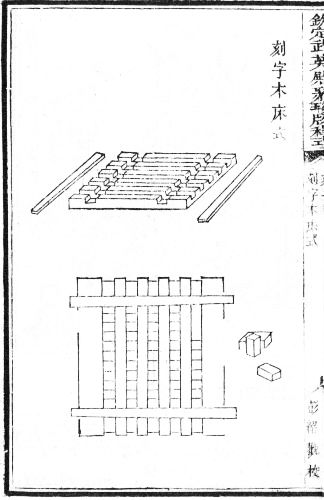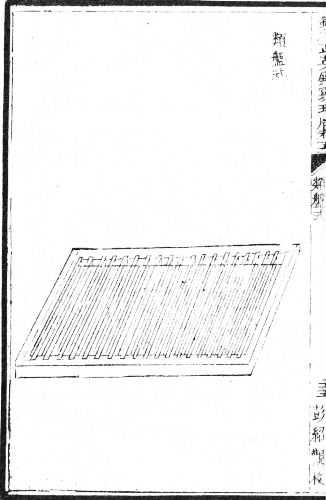(Qinding) Wuyingdian juzhenban chengshi (欽定)武英殿聚珍版程式 "(Imperially endorsed) Formulas for prints with moveable types from the Hall of Military Glory" is a short handbook on printing with moveable types (huozi 活字) compiled by Gingiyan (Ch. Jinjian 金簡, d. 1794) in 1776 on official order.
Gingiyan was a bondservant in the Plain Yellow Banner 正黃旗 of the Qing dynasty 清 (1644-1911) and was granted the clan name Gingiya 金佳. He rose to the post of ministerial secretary (zhushi 主事) in the Imperial Household Department (neiwufu 内務府) and was appointed Grand Minister (dachen 大臣) in 1772. A year later he took over the supervision of the imperial printing shop in the Wuying Hall as Editorial Grand Minister (zongcai dachen 總裁大臣) of the large project of the imperial series Siku quanshu 四庫全書. In 1774 he was made Vice Minister of Revenue (hubu shilang 戶部侍郎) and concurrently Vice Commander-in-chief (fudutong 副都統) of the Bordered Yellow Banner, decorated with a peacock feather. From 1781 on he served as Minister of Works (gongbu shangshu 工部尚書). He supervised the revision of the personal and geographical names in the official dynastic histories Liaoshi 遼史, Jinshi 金史 and Yuanshi 元史. Gingiyan ended his career as Minister of Personnel (libu shangshu 吏部尚書).
 |
 |
Left: Instrument to adjust the size of raw pieces for characters and white space (mucao, tong louzi shi 木槽、銅漏子式). Right: Bed for fixing wood pieces during the carving process (kezi muchuang shi 刻字木床式). |
|
 |
 |
Left: Grid to hold characters during the typesetting process (leipan shi 類盤式). Right: White paper with lines and center fold without characters (taoge shi 套格式). |
 |
 |
Left: Type case (zigui shi 字櫃式). Right: Wooden bars used for leading or white space (jiatiao, dingbu, zhongxin zongshi 夾條、頂木、中心木總式). From the Siku quanshu 四庫全書 edition. |
|
As a supervisor of the imperial printing shopm Gingiyan decided that a more systematic style of working had to be adhered to in order to make printing faster and less expensive. He submitted a memorial to the throne with suggestions for a more effective organisation of the printing shop. His main argument was that standardization would considerably lower cost and at the same time make sure a stable quality and print layout. Additionally, standardized characters (made of the wood of jujube trees) and faces would save a lot of time for the production of characters and tools for page spread.
The Qianlong Emperor 乾隆帝 (r. 1735-1795) accepted his suggestions and order Gingiyan to supervise the production of a handbook for the standardization in the imperial printing shop. Gingiyan also took care for the manufactuting of 250,000 moveable characters and standardized printing plates. The books created on the base of these new standards were called Wuyingdian juzen ban 武英殿聚珍版 "excellent prints from the Hall of Military Glory". The word junzhenban 聚珍版 so became a synonym for high quality moveable letter prints (huoziban 活字版).
The book fixing the standards was compiled with the objective to provide a pattern for printing with moveable types that could be imitated in the future by all other printing institutes. The book therefore consists of three parts. The first part includes all memorials to the throne concerning the printing of books with moveable types from the years 1773 to 1776. The most important of these memorials were written by Gingiyan himself and Prince Yunglong (Ch. Yongrong 永瑢, 1744-1790). They discuss the origin of book printing with moveable types, its process, the cost and materials, as well as the achievements of printing. The second part first describes the method of printing with moveable types and the production of the necessary instruments. It is divided into 15 short chapters that are partially illustrated. The last chapter is a kind of working schedule that enables a quick and effective printing process.
The Juzhenban chengshi demonstrates that printing with moveable letters of wood had achieved considerable results in the 18th century. It was not only a cheap method of printing but could also deliver excellent results that were better than types of lead or ceramics. The printing and wide spread of the book contributed to better results in all printing shops throughout the empire.
The Juzhenban chengshi is included in the series Lizhizhai congshu 勵志齋叢書, Wuyingdian juzhenban shu 武英殿聚珍版書 and Meishu congshu 美術叢書.
| 1 | 成造木子(附成造木子一圖和木槽銅漏子式兩圖) | |
| 2 | 刻字 (附刻字圖和刻字木床式圖) | |
| 3 | 字櫃 (有圖並式) | |
| 4 | 槽板 (有圖並式) | |
| 5 | 夾條 (分一分通長、半分通長、一分長短、半分長短四種) | |
| 6 | 頂木 (與夾條總/圖總式) | |
| 7 | 中心木 (有夾條、頂木、中心木總圖總式) | |
| 8 | 類盤 (有圖並式) | |
| 9 | 套格 (有圖並式) | |
| 10 | 擺書 (有圖) | |
| 11 | (平)墊版 | |
| 12 | 校對 | |
| 13 | 刷印 | |
| 14 | 歸類 | |
| 15 | 逐日輪轉辦法 (附輪轉擺印課程) |